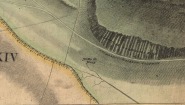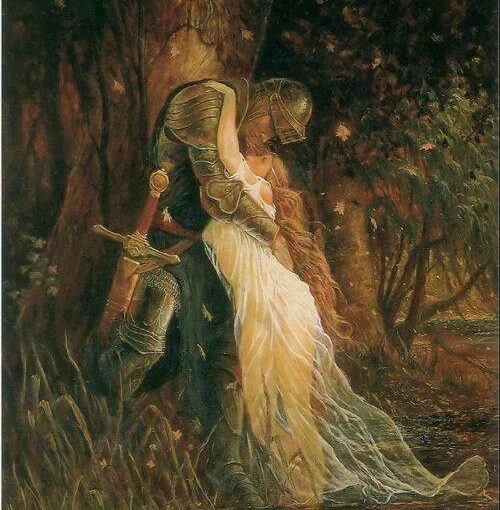The Water o’ Wearie’s Well (Child ballad #4B) è la variante della ballata “Lady Isabel and the Elf Knight”, in cui il Cavaliere elfo diventa uno spirito dell’acqua, creatura muta-forma che poteva apparire sotto le sembianze di cavallo oppure di giovane uomo/fanciulla.
Così è con l’arpa magica (invece del corno nella versione A) che la creatura fatata getta l’incantesimo del sonno sugli abitanti del castello per poter rapire la fanciulla.
A cavallo di un oscuro destriero, i due giungono ad un corso d’acqua chiamato Wearie’s Well. Qui il cavaliere ordina alla principessa di immergersi nell’acqua e poi di lasciarsi affogare, proprio come avevano fatto altre sette principesse prima di lei.
Ma a morire sarà il mutaforma (morte rituale): lei lo incanta con un bacio e lo trascina giù nell’acqua, affogandolo.
Sorge spontaneo chiedersi, come può una creatura dell’acqua affogare?!
[English translation]
The Water o’ Wearie’s Well (Child ballad #4B) is the variant of the ballad “Lady Isabel and the Elf Knight“, in which the Elf- Knight becomes a spirit of water, a shapeshifter creature that could appear under the guise of a horse or a young man / maiden.
With his magic harp (instead of the horn in version A) he casts the spell of sleep on the inhabitants of the castle in order to kidnap the princess.
Straddling a dark steed, the two come to a stream (or a pond) called Wearie’s Well. Here the knight orders the princess to plunge herself into the water and then to let herself drown, just as seven other princesses had done before her.
But it will be the shapeshifter to die (ritual death): she enchants him with a kiss and drags him down into the water, drowning him. The question arises spontaneously, how can a water fairy drown?!
Wearie’s Well
| La località in cui si trovano i Wells of Wearie non è oggi facile da individuare essendo andati distrutti durante la costruzione della linea ferroviaria che passa ai piedi dell’Arthur’s Seat, (uno dei Sette colli di Edimburgo) “I Wells of Wearie erano uno della dozzina di pozzi sacri e curativi che circondano il leggendario Arthur’s Seat ai margini di Edimburgo e le cui acque erano considerate soprannaturali. Segnato sulla mappa di Edimburgo di James Kirkwood nel 1821 come ‘Well of Wery’, questo sito dal nome curioso era famoso nei secoli precedenti come un eccellente rifornimento idrico per la popolazione locale – e anche “per alleviare il viaggiatore stanco” . Oggi, tutto quello che è rimasto sono dei piccoli stagni immediatamente sotto la strada, accanto al sentiero della linea ferroviaria, quando si esce dal lungo tunnel.“ La montagnola soprannominata “Il trono di Artù” (in inglese Arthur’s Seat) è uno dei siti leggendari in cui il dormiente re Artù attende il suo risveglio, secondo altri questo era il sito della leggendaria Camelot. La sua sagoma richiama vagamente un leone rannicchiato. | The place where the Wells of Wearie are located is not easy to find today, having been destroyed during the construction of the railway line that passes at the foot of Arthur’s Seat, (one of the Seven Hills of Edinburgh) The Wells of Wearie were one of nearly a dozen sacred and healing wells surrounding legendary Arthur’s Seat at the edge of Edinburgh, and whose waters were also said to have supernatural properties. Shown on James Kirkwood’s 1821 map of Edinburgh as the ‘Well of Wery’, this curiously named site was renowned in earlier centuries as an excellent water supply for the local people — “to cure the weary traveller” for one. Today, all we have left of them are the small ponds immediately below the road, next to the converted railway line path, just as you come out of the long tunnel. (from here)  The Arthur’s Seat is one of the legendary sites where the sleeping King Arthur his awakening, according to others this was the site of the legendary Camelot. Its shape vaguely recalls a huddled lion. |
There came a bird (1) oot o a bush
On water for tae dine
An sighing said this lady fair
“oh woe’s this heart o mine!”
And he’s ta’en a harp(2) intae his had
And he’s harped them all asleep
Except it was the King’s daughter
Who a wink couldna get
And he’s mounted on his berry-brown steed
Ta’en her behind himsel’
And on they rode to that water
That they call Wearie’s Well(3)
“Wide in, wide in, my lady fair
Nae harm shall ye befa’
For oftimes hae I watered my steed
At the water o Wearie’s Well”
And the very first step that she stepped in
She stepped in unto the knee
And sighing said this lady fair
“This water’s nae for me”
“Wide in, wide in, my lady fair
Nae harm shall ye befa’
For oft times hae I watered my steed
At the water o Wearie’s Well”
And the very next step that she stepped in
She stepped in to the chin
And crying said this lady fair
“I fear I’m too far in!”
“Seven King’s daughters have I drowned here
At the water o Wearie’s Well
And I’ll mak ye the eighth o them
And I’ll ring the common bell(4)”
“If I am standing here, she said,
This dowie death tae dee
A kiss from o yer comely lips
I’m sure would comfort me”
So he’s mounted ower his saddle bow
To kiss her cheek and chin
And she’s ta’en him in her airms twa
And she’s thrown him headlong in
“Seven King’s daughters have ye drowned here
At the water o Wearie’s Well
I’ll make ye bridegroom tae them all
And I’ll ring the bell myself”
FOOTNOTES
(1) once some birds were carrying bad news. For example the English fishermen believed that the curlews announced a shipwreck and death when they stooped and rose on the coast weeping sadly; as well as that the cormorants and the gulls on the rocks are waiting for the souls of the fishermen who died at sea to torment the living.
(2) the harp is a magical instrument used by fairy creatures and bards see
(3) the well is located south-west of Arthur’s Seat the hill east of Edinburgh, according to the etymologist it could be translated as “Devil pond”, but also “Well of Laments” or “Well of Wonders”. A Jacobite song called “Bonnie Wells o’Wearie” commemorates this location near Duddingston Loch
(4) a bell was often placed in dangerous areas to sound the alarm and call people
Tony Cuffe in Sae Will We Yet, 2003
https://www.discogs.com/release/5094779-Tony-Cuffe-Sae-Will-We-Yet

traduzione italiana di Cattia Salto
Là venne un uccello(1) fuori da un cespuglio
sull’acqua per pranzare
e sospirando disse questa bella dama
“O che dolore ho nel cuore!”
Ed egli prese un’arpa(2) tra le mani
e li fece addormentare tutti
tranne la figlia del Re
che non riusciva a chiudere occhio,
e lui montò sul suo destriero morello
facendola montare dietro
e cavalcarono verso l’acqua
detta Stagno dei Desideri(3)
“Al largo, al largo bella madamigella,
niente di male vi accadrà,
che assai spesso ho abbeverato il mio destriero
alle acque dello Stagno dei Desideri”
E con il primo passo che fece
lei si immerse fino al ginocchio
e sospirando disse questa bella dama
“L’acqua non fa per me”
“Avanti, avanti, bella madamigella
niente di male vi accadrà
che assai spesso ho abbeverato il mio destriero
alle acque dello Stagno dei Desideri”
E al passo successivo che fece
lei affondò fino al mento
e gridando disse questa bella dama
“Temo di essere troppo lontana (dalla riva)”
“Sette figlie di Re ho annegato qui
alle acque dello Stagno dei Desideri”,
ti farò l’ottava di esse
e suonerò la campana del paese(4)”
“Se sono qui -disse lei –
per fare questa morte in acqua,
un bacio dalle tue labbra belle
di certo mi daranno conforto”
Così lui si sporse dalla sella
per baciare la sua guancia e il mento
e lei lo prese tra le sue braccia
e lo gettò a testa in giù
“Sette figlie di re hai affogato qui
alle acque dello Stagno dei Desideri,
ti farò lo sposo di tutte loro
e suonerò la campana da me!”
NOTE
(1) un tempo molti uccelli erano portatori di cattive notizie. Ad esempio i pescatori inglesi ritenevano che i chiurli annunciassero naufragio e morte quando si abbassavano e alzavano sulla costa piangendo tristemente; come pure che i cormorani e i gabbiani fossero sugli scogli in attesa delle anime dei pescatori morti in mare per tormentare i viventi.
(2) l’arpa è uno strumento magico per eccellenza utilizzato da creature fatate e bardi per i loro incantesimi vedi]
3) il pozzo si trova a sud-ovest di Arthur’s Seat la collina ad est di Edimburgo, secondo l’etimologa si potrebbe tradurre come Pozzo del Diavolo, ma anche Pozzo dei lamenti oppure pozzo dei Desideri. Una canzone giacobita s’intitola Bonnie Wells o’Wearie proprio per commemorare questa località vicino a Duddingston Loch
(4) una campana era spesso collocata nelle zone pericolose per suonare l’allarme e richiamare la gente
English translation Cattia Salto
There came a bird out o a bush
On water for to dine
An sighing said this lady fair
“oh woe’s this heart of mine!”
And he has taken a harp into his had
And he has harped them all asleep
Except it was the King’s daughter
Who a wink couldna get
And he’s mounted on his berry-brown steed
Taken her behind himself
And on they rode to that water
That they call Wearie’s Well
“Walk in, walk in, my lady fair
No harm shall you befall
For oftimes have I watered my steed
At the water o Wearie’s Well”
And the very first step that she stepped in
She stepped in unto the knee
And sighing said this lady fair
“This water is no for me”
“Walk in, walk in, my lady fair
No harm shall you befall
For oft times hae I watered my steed
At the water o Wearie’s Well”
And the very next step that she stepped in
She stepped in to the chin
And crying said this lady fair
“I fear I’m too far in!”
“Seven King’s daughters have I drowned here
At the water o Wearie’s Well
And I’ll make you the eighth of them
And I’ll ring the common bell”
“If I am standing here, she said,
This sad death to die
A kiss from your comely lips
I’m sure would comfort me”
So he’s mounted over his saddlebow
To kiss her cheek and chin
And she’s taken him in her airms two
And she’s thrown him headlong in
“Seven King’s daughters have you drowned here
At the water o Wearie’s Well
I’ll make you bridegroom to them all
And I’ll ring the bell myself”
